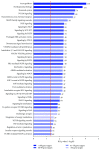Expanding the miRNA Transcriptome of Human Kidney and Renal Cell Carcinoma
- PMID: 30057905
- PMCID: PMC6051088
- DOI: 10.1155/2018/6972397
Expanding the miRNA Transcriptome of Human Kidney and Renal Cell Carcinoma
Abstract
Despite advancements in therapeutic strategies, diagnostic and prognostic molecular markers of kidney cancer remain scarce, particularly in patients who do not harbour well-defined driver mutations. Recent evidence suggests that a large proportion of the human noncoding transcriptome has escaped detection in early genomic explorations. Here, we undertake a large-scale analysis of small RNA-sequencing data from both clear cell renal cell carcinoma (ccRCC) and nonmalignant samples to generate a robust set of miRNAs that remain unannotated in kidney tissues. We find that these novel kidney miRNAs are also expressed in renal cancer cell lines. Moreover, these sequences are differentially expressed between ccRCC and matched nonmalignant tissues, implicating their involvement in ccRCC biology and potential utility as tumour-specific markers of disease. Indeed, we find some of these miRNAs to be significantly associated with patient survival. Finally, target prediction and subsequent pathway analysis reveals that miRNAs previously unannotated in kidney tissues may target genes involved in ccRCC tumourigenesis and disease biology. Taken together, our results represent a new resource for the study of kidney cancer and underscore the need to characterize the unexplored areas of the transcriptome.
Figures




References
-
- Canadian Cancer Statistics Advisory Committee. Canadian Cancer Statistics 2018. Toronto, ON, Canada: Canadian Cancer Society; 2018.
LinkOut - more resources
Full Text Sources
Other Literature Sources

